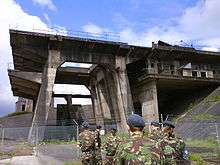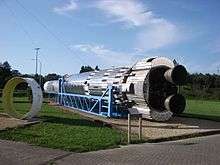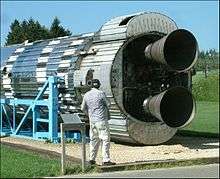Europa (rocket)
 Europa II rocket | |
| Function | Orbital carrier rocket |
|---|---|
| Manufacturer | ELDO |
| Country of origin | Europe |
| Size | |
| Height | 33 m |
| Diameter | 3.05 m |
| Mass | 104,670 kg |
| Stages | 3 - 4 |
| Capacity | |
| Payload to GTO |
Europa I: 200 kg Europa II: 360 kg |
| Launch history | |
| Status | Retired |
| Launch sites |
LA-6, Woomera CECLES, CSG (Kourou) |
| Total launches |
11 5 Blue Streak 2 Blue Streak/Coralie 3 Europa I 1 Europa II |
| Successes |
4 4 Blue Streak |
| Failures |
7 1 Blue Streak 2 Blue Streak/Coralie 3 Europa I 1 Europa II |
| First flight |
Blue Streak: 4 June 1964 Coralie: 4 August 1967 Europa I: 29 November 1968 Europa II: 5 November 1971 |
| Last flight |
Blue Streak: 14 November 1966 Coralie: 4 December 1967 Europa I: 12 November 1970 Europa II: 5 November 1971 |
| First stage - Blue Streak | |
| Engines | 2 RZ.2 |
| Thrust | 170,565 kgf (1.67267 MN) |
| Specific impulse | 282 s |
| Burn time | 156 seconds |
| Fuel | RP-1/LOX |
| Second stage (Optional) - Coralie (rocket) | |
| Engines | 4 LRBA Vexin-A |
| Thrust | 28,000 kgf |
| Specific impulse | 277 s |
| Burn time | 96 seconds |
| Fuel | UDMH/N2O4 |
| Third stage - Astris (rocket) | |
| Engines | 1 Astris |
| Thrust | 2,380 kgf (23.3 kN) |
| Specific impulse | 310 sec |
| Burn time | 330 seconds |
| Fuel | N2O4/Aerozine 50 |
| Fourth stage - P068 (Europa II) | |
| Engines | 1 Solid |
| Thrust | TBC |
| Burn time | TBC |
| Fuel | Solid |
The Europa rocket was an early expendable launch system of the European Launcher Development Organisation (ELDO), which was the precursor to the European Space Agency and its Ariane family of launchers. Europa was built to develop space access technology and put European-wide telecommunication and meteorological satellites in orbit. The rocket primarily consisted of Blue Streak, Coralie, and Astris rocket stages.[1]
History
The British Blue Streak ballistic missile was cancelled in 1960, when it was realised it could not compete with the types of missile that the Americans or Russians were building. As part of deciding how to implement Blue Streak inconspicuously, the British inadvertently arrived at the concept of the missile launch facility (missile silos), although none were actually built in Britain. The difficult storage of liquid oxygen in the rocket stalled the introduction of Blue Streak.
The Royal Aircraft Establishment at Farnborough was given the job of considering how the missile could be adapted as a satellite launching vehicle, in conjunction with other rocket stages. Peter Thorneycroft, Baron Thorneycroft, the Minister of Aviation, in 1961 thought about a joint European project, the main intention being not to waste the (advanced) development of the rocket, and not to leave space exploration to the Americans and Russians. A possible Anglo-French collaboration was looked at, and ELDO was signed on 16 April 1962.
The three-stage design was arrived at, and given the name Eldo A, later named Europa.
In January 1965, the French thought the initial three-stage rocket design would not be sufficiently advanced to carry the size of payloads required, and another rocket - Eldo B - with liquid hydrogen as fuel for the second and third stages to be the better first design, partly due to reduce the cost of the project by eliminating transition test launchers. It would still use the Blue Streak as the first stage. ELDO later disagreed, but the French would get their way, as Eldo B would become Ariane, first launching in 1979.
The programme was initiated by the UK and the first launch was planned for November 1966, but the first two-stage launch occurred in August 1967, with three stages (Europa 1) in November 1968.
By April 1966, estimated costs had increased to £150 million, from an initial estimated of £70 million. Hopes were not high that it would be suitable for the job. The Italians wanted to give up on ELDO and go for a single European space organisation, not divided nationally as ELDO.
Britain was contributing 40% of the costs. In early June 1966, the British government (Fred Mulley) decided it could not afford the cost, and wanted to leave the ELDO organisation - one of the few European organisations in which it was a lead player. This was also at a time when satellite technology was about to change the world. But geosynchronous satellites would need to be 22,000 miles (35 400 km) above Earth, not Europa 1's 125 miles (200 km) altitude. Britain's contribution was reduced to 27%.
In mid-November 1968, a European Space Conference in Bonn decided on a proposal to merge ELDO with ESRO to form a pan-European space authority by early 1970; ESA would not be formed until 1975. Britain was lukewarm to the idea, because it did not believe Europe could launch satellites economically.
By 1970 the French launch base in French Guiana had cost £45 million, and in that year France became the most important partner in the project, then planning to build two-thirds of the rocket as well as owning the launch site. Although only on paper, Britain's involvement in the project was much reduced, after being largely responsible (with an Australian launch site) for getting the entire project going in the first place. However all of the launchers, to the very end, were completely dependent on the British rocket in the first stage.
In 1970 the project was under a perceived economic threat from America's offer to fly satellites for foreign powers on a reimbursable basis. That agreement had been signed between ESRO and NASA on 30 December 1966 and by 1970 it was becoming clear that the advantage in having a national launch vehicle was insufficient to justify the cost. In 1972 NASA approved development of the Shuttle which many perceived would offer greater savings in having satellites launched on this system. That proved false.
By 1971, over £250 million had been spent on the project, with Europa 2 costing over £4 million.
Division of labour
Tasks were to be distributed between nations: the United Kingdom would provide the first stage (derived from the Blue Streak missile), France would build the second and Germany the third stage. It would carry a satellite designed and built in Italy, weighing around a ton. The telemetry was to be developed by the Netherlands. Belgium was to develop the down range ground guidance system.
By 1969 ELDO was beginning to realise that dividing work up by country led to not enough overall collaboration, with a disjointed framework of planning. This disjointed structure led to the many unsuccessful launch attempts, with no-one really in charge.
The West Germans blamed the explosion of Europa 2 in November 1971 on the immense divisions within ELDO.

Programme of launcher types
The Europa programme was divided into 4 successive projects :
- Europa 1: 4 unsuccessful launches
- Europa 2: 1 unsuccessful launch
- Europa 3: Cancelled before any launch occurred
- Europa 4: Study only, later cancelled
Outcome
The project was marred by technical problems. Although the first stage (the British Blue Streak) launched successfully on each occasion, it was the second or third stage that failed.
Background
Payloads
The payload for the rocket was overseen by the European Space Research Organization - ESRO. Satellites were proposed to be launched by 1969 or 1970, in a circular polar orbit at an altitude of 125 miles (200 km). ESRO organised the development of early satellites such as ESRO 2B (Iris), built by Hawker Siddeley Dynamics and Engins Matra.
In 1967, it was decided the payloads were to be launched by 1970 from French Guiana, not Australia. In April 1969, Britain decided to invest in a satellite television project by the European Broadcasting Union.
By the early 1970s the French-German Symphonie communications satellite were in production, but by then Europa was cancelled in November 1971.
First stage
It was tested three times in 1964, and also in 1965, with a dummy upper stages in 1965. It was assisted by the British National Committee for Space Research. The chief project engineer of the rocket's assembly at the space projects division of Hawker Siddeley Dynamics was Dr Geoffrey Pardoe, also the project manager of Blue Streak from 1956 to 1960 (when under de Havilland). In August 1965, the Blue Streak was tested (static firing trial) with (complete full-weight) dummy upper stages at RAF Spadeadam (the site was owned by Rolls Royce), with first successful firing on 23 September 1965 lasting 135 seconds. Five days later the site was visited by the Minister of Aviation, Roy Jenkins.
In January 1966, it had been transported to Adelaide, Australia, for launches later that year. Also in the UK in 1967 the go-ahead had been given for the UK's (separately developed) three-stage Black Arrow rocket launcher (made by Westland Aircraft, with Bristol Siddeley rocket engines developed at the Rocket Propulsion Establishment at Westcott, Buckinghamshire) - Britain did not need to rely on Europa, and Black Arrow would be ready first.

Britain then withdrew from ELDO, to concentrate on the Black Arrow, but was committed to supplying ELDO with two Blue Streak rocket stages a year until 1976. At this time in 1969, Britain was spending £30 million a year on space, controlled from the Space Division of the Ministry of Technology. Britain was still dealing with, and funding, ESRO.
Due to Britain's withdrawal in 1968, ELDO in June 1969 had other ideas than staying with the Blue Streak launcher for Europa's first stage, to give technical work to countries that were still (loyally) part of the organisation. Unfortunately, few other European countries had sufficiently advanced technical knowledge of rockets at that time. The Blue Streak had worked much more successfully than the other engine stages. Nonetheless Blue Streak, ELDO's most successful rocket to that date, was replaced. On 28 April 1970 at a meeting in Paris, ELDO replaced the Blue Streak with the French-made Diamant. Britain's most significant involvement with the project came to an end. The following year Britain would put its own rocket programme, Black Arrow, (prematurely) out of operation.
By 1970 Hawker Siddeley's Blue Streak launcher had cost £100 million to develop. It was still planned to be used on Europa until 1973, when Diamant would be used as the first stage. Blue Streak was used for the Europa 2's one and only launch on 5 November 1971.

Second stage
The French had developed rockets through their Véronique, which was originally planned to be the second stage.
The Coralie was to be tested at Colomb-Béchar in the Béchar Province of western Algeria. Tests began in December 1965 at Vernon, Eure in France, west of Paris. The first successful firing was on 28 November 1966 in northern Africa.
Société Européenne de Propulsion (SEP), at Vernon, would later develop the Viking main engines for Ariane.
Third stage
This was made in Germany by Entwicklungsring Nord (ERNO Raumfahrttechnik GmbH), based in Bremen, from 1969. The German consortium itself was known as Arbeitsgemeinschaft Satellitenträgersystem (ASAT), which consisted of ERNO and MBB. Although assembled by ERNO in Bremen, the engine was made by Société d'Etudes pour la Propulsion par Réaction (SEPR), part of Snecma in Villaroche.
On 2 July 1969, on a launch at Woomera of the three-stage 108 foot (33 m) rocket, the Astris third stage failed to light, after the other two had successfully fired.
After the third stage, an apogee kick motor would be used to put a satellite into a synchronous orbit.
ERNO would later develop the second stage for the Ariane launcher, at the Vereinigte Flugtechnische Werke (VFW) factory in Bremen, later owned by Daimler Benz Aerospace then DaimlerChrysler Aerospace (DASA).
Project history
The first test took place at 9.14am local time on 5 June 1964 at Woomera. Thrust was terminated after 147 seconds, 6 seconds earlier than planned. The point of impact was 625 miles (1000 km) from the launch site, instead of the intended 950 miles (1500 km). It reached a height of 110 miles (180 km) and a maximum speed of 6,400 mph (10 300 kph). Near space is considered to be around 60–70 miles (90-110 km). The craft's structure was built by Hawker Siddeley Dynamics and the rocket engine were the Rolls-Royce RZ.2. At this stage the French and German rocket stages were mere fibre-glass scale models.
The first full-size launch, weighing in total 104 tons, took place at Woomera on 24 May 1966, with dummy upper stages. Tests were conducted by Australia's Weapons Research Establishment and the French Laboratoire de Recherche en Balistique et Aérodynamique (based at Vernon). After two minutes and fifteen seconds, six seconds short of the planned flight, the rocket was destroyed as it was thought (by an impact predictor) to be veering west of the planned trajectory. However, the rocket was exactly on courses and inaccurate readings had been picked up by a radar station 120 miles (190 km) away.
Two-stage testing was planned for June 1967. At 11.12pm GMT on 30 November 1968, the first three-stage Europa 1 launcher put a 550 lb (250 kg) Italian satellite-model into orbit.
The first launch from French Guiana on 5 November 1971 was also the first launch of the four-stage Europa 2. It exploded over the Atlantic after three minutes. It landed in the sea 302 miles (486 km) from the launch site, and had reached a height of 40 miles (65 km).
Europa rocket launches
| Flight | Date | Model | Stages | Payload | Launch site |
|---|---|---|---|---|---|
| |
5 June 1964 | Blue Streak | |
- | Woomera |
| |
20 October 1964 | Blue Streak | |
- | Woomera |
| |
22 March 1965 | Blue Streak | |
- | Woomera |
| |
24 May 1966 | Blue Streak | |
upper stage mockups | Woomera |
| |
15 November 1966 | Blue Streak | |
upper stage mockups | Woomera |
| |
4 August 1967 | Coralie | |
third stage mockup | Woomera |
| |
5 December 1967 | Coralie | |
third stage mockup | Woomera |
| |
30 November 1968 | Europa 1 | |
third stage mockup | Woomera |
| |
31 July 1969 | Europa 1 | |
satellite mockup | Woomera |
| |
6 June 1970 | Europa 1 | |
satellite mockup | Woomera |
| |
5 November 1971 | Europa 2 | |
satellite mockup | Kourou |

Notes
References
- Bleeker, J. A. M.; Huber, M.; Geiss, Johannes (2002). The Century of Space Science. Dordrecht: Kluwer Academic Publications. ISBN 0792371968.
- Bonnet, R. M. (1998). "Europe's Final Frontier". Forum for Applied Research and Public Policy. University of Tennessee. 13 (3).
- Reuters (5 August 1967). "A European Rocket Crashes on Flight". New York Times.
- Harvey, Brian (2003). Europe's Space Programme: To Ariane and Beyond. Berlin: Springer-Verlag. ISBN 1852337222.
- Morgan, Dan (24 July 1969). "Europe's Rocketry Beset By Failure". Washington Post. p. A15.
External links
| Wikimedia Commons has media related to Europa (rocket). |
- Wade, Mark. "Europa". Encyclopedia Astronautica.
- "Blue Streak". Engineering Britain's Superweapons. August 2009. Channel 4.